As a gardener, I am always looking for ways to maximize the health and beauty of my plants. One way to do this is through companion planting. Companion planting is the practice of planting two or more species of plants together to benefit each other. When it comes to coneflowers, there are many companion plants that can help improve their growth and overall health.
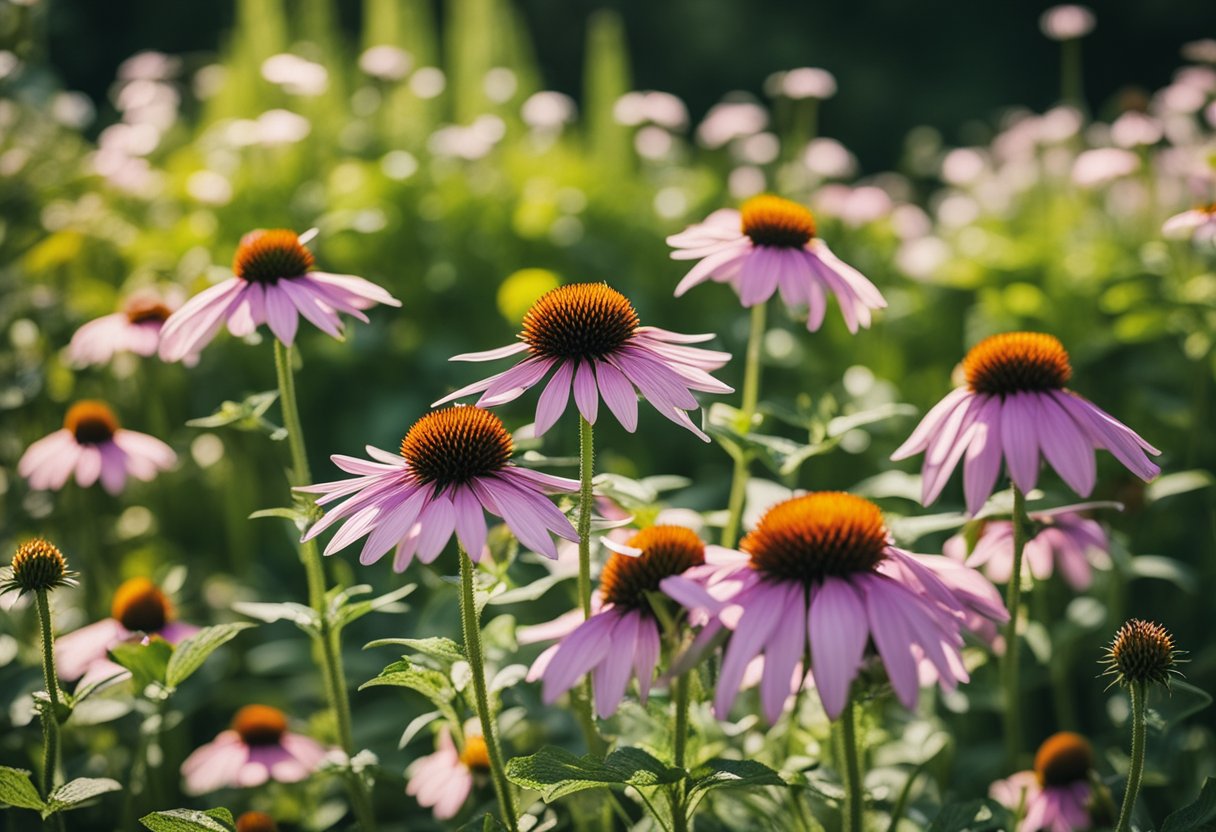
Coneflowers are a popular choice for gardeners because of their vibrant colors and ability to attract pollinators. They are also relatively low-maintenance, making them a great choice for both novice and experienced gardeners. When planted with the right companion plants, coneflowers can thrive even more. Some companion plants can help repel pests, while others can improve soil health or provide shade. In this article, I will explore the benefits of companion planting with coneflowers and provide some suggestions for the best companion plants to use.
Key Takeaways
- Companion planting with coneflowers can improve their growth and overall health.
- Some companion plants can help repel pests, while others can improve soil health or provide shade.
- Good companion plants for coneflowers include black-eyed susans, bee balm, and yarrow.
Benefits of Companion Planting with Coneflowers
As an avid gardener, I have found that companion planting with coneflowers can be incredibly beneficial for my garden. Coneflowers, also known as Echinacea, are native to North America and are a popular choice for gardeners due to their attractive flowers and easy maintenance. When planted alongside other compatible plants, coneflowers can help improve soil health, attract pollinators, and even deter pests. In this section, I will discuss some of the benefits of companion planting with coneflowers.
Pest Management
Coneflowers are known to attract beneficial insects such as ladybugs, lacewings, and hoverflies, which can help control harmful pests like aphids and spider mites. Planting coneflowers alongside other plants that attract beneficial insects, such as dill, fennel, and yarrow, can create a natural pest management system in your garden. Additionally, planting coneflowers alongside plants that repel harmful insects, such as marigolds and garlic, can further improve pest control in your garden.
Pollinator Attraction
Coneflowers are a favorite of bees, butterflies, and other pollinators due to their nectar-rich flowers. Planting coneflowers alongside other plants that attract pollinators, such as milkweed, bee balm, and lavender, can help create a diverse and thriving ecosystem in your garden. This can lead to increased pollination, which can result in higher yields for your vegetable plants.
Soil Health Improvement
Coneflowers have deep taproots that can help break up compacted soil and improve drainage. Additionally, coneflowers are known to attract beneficial soil microorganisms, which can help improve soil health and nutrient availability. Planting coneflowers alongside other plants that have similar soil requirements, such as black-eyed susans and coreopsis, can help create a healthy and balanced soil ecosystem in your garden.
Aesthetic Combinations
Coneflowers are a beautiful addition to any garden, and they can be paired with a variety of other plants to create stunning visual displays. Planting coneflowers alongside other plants with complementary colors and textures, such as ornamental grasses and sedums, can create a visually appealing and dynamic garden. Additionally, planting coneflowers alongside other plants that bloom at different times of the year can help ensure that your garden is in bloom throughout the growing season.
Companion planting with coneflowers can provide numerous benefits for your garden, including improved pest management, pollinator attraction, soil health improvement, and aesthetic combinations. By planting coneflowers alongside other compatible plants, you can create a thriving and beautiful garden ecosystem.
Best Companion Plants for Coneflowers
Coneflowers are stunning and vibrant flowers that can add a pop of color to any garden. But did you know that planting them alongside certain companion plants can improve their growth and health? Here are some of the best companion plants for coneflowers:
Herbs as Companions
Herbs are excellent companion plants for coneflowers. They not only add fragrance and flavor to your garden but also help repel pests. Some of the best herbs to plant alongside coneflowers include:
- Basil: This herb is a natural pest repellent and also attracts bees and other beneficial insects to the garden.
- Rosemary: Rosemary repels pests such as mosquitoes and cabbage moths, and its strong scent can mask the smell of nearby plants that may attract pests.
- Thyme: Thyme is another herb that repels pests and attracts beneficial insects such as bees and butterflies.
Vegetables and Coneflowers
Vegetables can also make excellent companion plants for coneflowers. They can help improve soil quality and attract pollinators to the garden. Some of the best vegetables to plant alongside coneflowers include:
- Tomatoes: Tomatoes and coneflowers are a great combination as they both attract pollinators and repel pests such as aphids and whiteflies.
- Peppers: Peppers are another vegetable that can help repel pests and attract pollinators to the garden.
- Cucumbers: Cucumbers and coneflowers make excellent companions as cucumbers help improve soil quality and attract bees and other pollinators.
Ornamental Grasses
Ornamental grasses can add texture and movement to your garden, and they also make great companion plants for coneflowers. Some of the best ornamental grasses to plant alongside coneflowers include:
- Switchgrass: Switchgrass is a native grass that can help improve soil quality and provide a natural habitat for beneficial insects.
- Little Bluestem: Little Bluestem is another native grass that can add color and texture to your garden and attract beneficial insects.
Annuals and Perennials
Annuals and perennials can also make great companion plants for coneflowers. They can add color and texture to your garden and attract pollinators. Some of the best annuals and perennials to plant alongside coneflowers include:
- Black-eyed Susan: Black-eyed Susan and coneflowers are a great combination as they both attract pollinators and add a pop of color to your garden.
- Salvia: Salvia is another plant that can attract pollinators and add color to your garden.
- Yarrow: Yarrow is a hardy perennial that can attract beneficial insects and improve soil quality.
By planting these companion plants alongside your coneflowers, you can create a healthy and vibrant garden that is sure to impress.
Planting Strategies
When it comes to planting Coneflowers, there are a few key strategies to keep in mind to ensure a successful garden. In this section, I will cover three important considerations: spatial arrangement, seasonal considerations, and succession planting.
Spatial Arrangement
Coneflowers are great companion plants for a variety of other species, including Black-Eyed Susans, Bee Balm, and Coreopsis. When planting Coneflowers alongside other plants, it’s important to consider their height and spread. Coneflowers can grow up to three feet tall and two feet wide, so be sure to give them plenty of space to avoid overcrowding. I recommend spacing Coneflowers at least 18 inches apart to allow for proper growth.
Seasonal Considerations
Coneflowers are hardy perennials that can thrive in a variety of climates. However, they do have specific seasonal requirements that should be taken into account. Coneflowers prefer full sun and well-draining soil, so be sure to choose a location that receives at least six hours of direct sunlight each day. Additionally, Coneflowers bloom from mid-summer through early fall, so plan your planting accordingly to ensure a vibrant and long-lasting display.
Succession Planting
To ensure a continuous display of Coneflowers throughout the growing season, consider succession planting. Succession planting involves planting multiple batches of seeds or seedlings at different times to stagger the bloom times. This can be done by planting a new batch of Coneflowers every two to three weeks from early spring through mid-summer. By doing so, you can enjoy a vibrant and colorful garden filled with Coneflowers all season long.
Coneflowers are a beautiful and versatile addition to any garden. By following these planting strategies, you can ensure a successful and vibrant display of these stunning flowers.
Coneflower Care with Companions
As a gardener, I have found that companion planting is an excellent way to ensure that my plants grow healthy and strong. Coneflowers are no exception, and they thrive when planted alongside certain companion plants. In this section, I will discuss the best practices for caring for coneflowers with their companion plants.
Watering Needs
Coneflowers require moderate watering, and they prefer well-draining soil. When planting coneflowers with companion plants, it is important to ensure that the watering needs of each plant are similar. For example, planting coneflowers with drought-tolerant companion plants like yarrow or sedum can help reduce the amount of water needed to maintain the garden.
Mulching Techniques
Mulching is an essential practice for maintaining healthy soil and moisture levels. When planting coneflowers with companions, I recommend using organic mulch, such as shredded leaves or bark. This helps to retain moisture in the soil and suppress weed growth. Additionally, mulching can help regulate soil temperatures, which is particularly important when planting coneflowers with heat-sensitive companion plants.
Fertilization Practices
Coneflowers are low-maintenance plants that do not require heavy fertilization. However, when planting coneflowers with companion plants, it is important to ensure that the fertilizer needs of each plant are similar. For example, planting coneflowers with nitrogen-fixing companion plants like legumes can help reduce the amount of fertilizer needed to maintain the garden.
Caring for coneflowers with their companion plants requires attention to detail and careful planning. By following the best practices for watering, mulching, and fertilization, gardeners can ensure that their coneflowers and companion plants thrive together.
Common Challenges
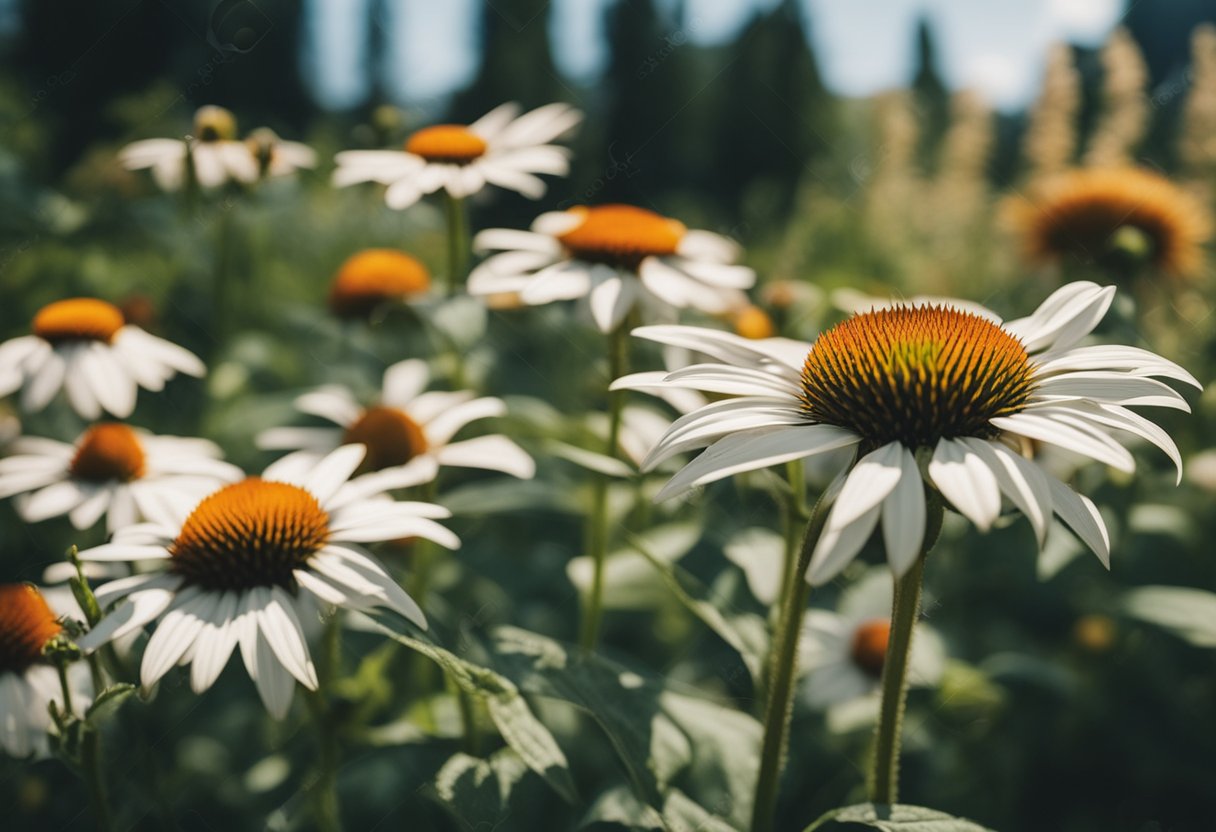
As with any plant, Coneflowers can face certain challenges that may affect their growth and overall health. In this section, I will discuss some of the most common challenges that Coneflowers and their companion plants may face.
Invasive Species
One of the biggest challenges when it comes to companion planting is dealing with invasive species. Some plants that are commonly used as companion plants for Coneflowers, such as mint and oregano, can quickly take over the garden if not properly managed. To prevent this, it is important to plant these species in containers or in designated areas of the garden where they can be easily controlled.
Disease Management
Another challenge that Coneflowers and their companion plants may face is disease. Coneflowers are susceptible to several diseases, including powdery mildew and aster yellows. To prevent the spread of disease, it is important to practice good garden hygiene, including removing any infected plants and debris from the garden. Additionally, using disease-resistant varieties of Coneflowers and companion plants can help prevent the spread of disease.
Competition for Resources
Competition for resources, such as water and nutrients, can also be a challenge when it comes to companion planting. To prevent competition, it is important to choose companion plants that have similar water and nutrient requirements as Coneflowers. Additionally, using mulch around the base of plants can help retain moisture and prevent competition for nutrients.
While there are some challenges that come with companion planting Coneflowers, these challenges can be easily managed with proper planning and maintenance. By being aware of the potential challenges and taking steps to prevent them, gardeners can enjoy a beautiful and thriving garden full of Coneflowers and their companion plants.
Design Inspirations
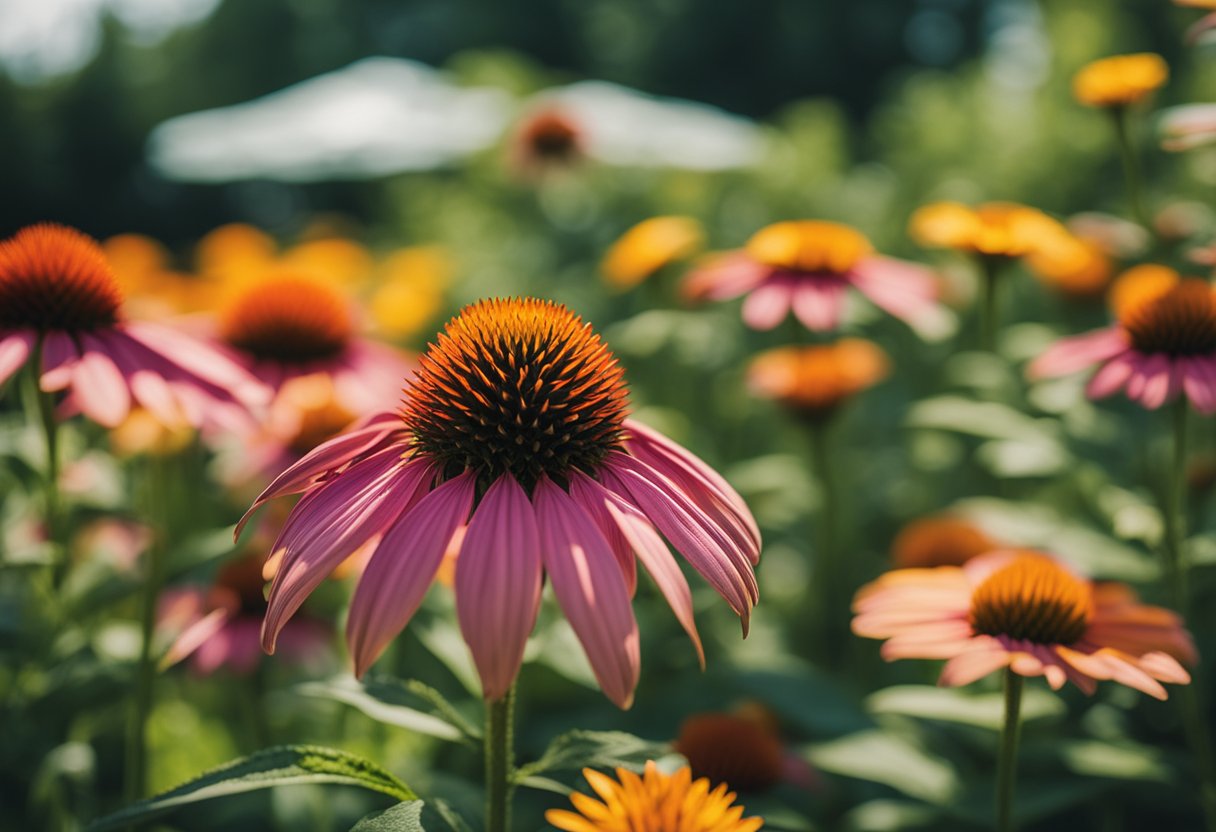
As a gardener, I always strive to create beautiful and harmonious landscapes. Designing a garden with Coneflower Companion Plants is no exception. In this section, I will share some design inspirations that can help you create stunning and cohesive garden beds.
Color Schemes
One of the most effective ways to create a beautiful garden is by using a color scheme. When planning your Coneflower Companion Plants, consider the colors of the flowers and foliage. For example, you can create a monochromatic scheme by using different shades of purple coneflower, or a complementary scheme by pairing yellow coneflower with purple salvia. You can also use a triadic scheme by combining purple coneflower, yellow coreopsis, and orange butterfly weed.
Texture Contrasts
Texture contrasts can add depth and interest to your garden design. When selecting Coneflower Companion Plants, consider the texture of their foliage and flowers. For example, you can pair the spiky flowers of purple coneflower with the delicate flowers of shasta daisy. You can also combine the fine-textured foliage of Russian sage with the broad leaves of hosta.
Height Variations
Creating height variations in your garden can add dimension and drama to your design. When selecting Coneflower Companion Plants, consider their height at maturity. For example, you can create a layered effect by planting tall coneflower in the back of the bed, medium-height black-eyed susan in the middle, and low-growing sedum in the front. You can also use tall grasses such as feather reed grass to create a natural screen or backdrop for your Coneflower Companion Plants.
Incorporating these design inspirations can help you create a beautiful and cohesive garden with Coneflower Companion Plants. By considering color schemes, texture contrasts, and height variations, you can create a garden that is not only visually stunning but also functional and sustainable.
Related Post:
10 Stunning Varieties of Vine Plant With Purple Flowers
Wildlife Considerations
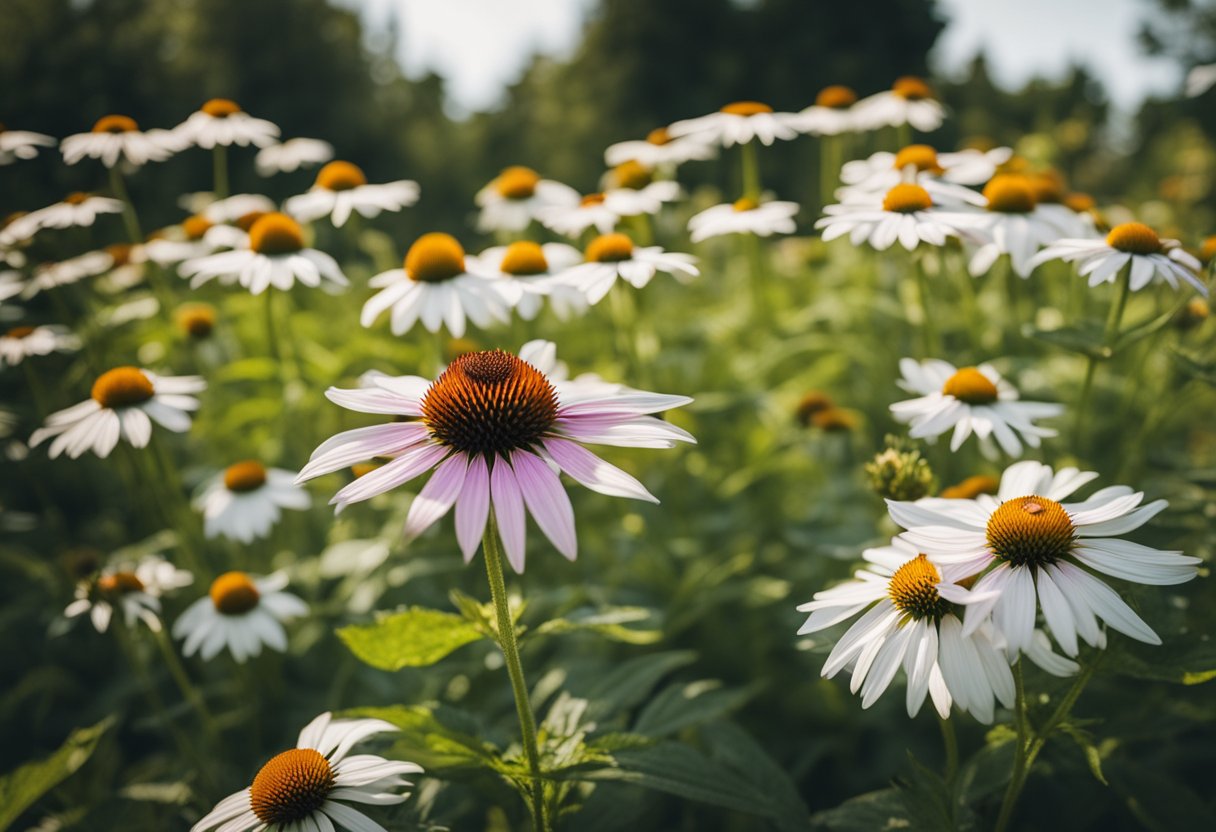
As a gardener interested in companion plants for Coneflowers, I also want to attract wildlife to my garden. Here are some considerations for attracting butterflies, birds, and beneficial insects.
Attracting Butterflies
Butterflies are attracted to Coneflowers and several other plants. A few examples of companion plants that attract butterflies are:
- Milkweed: Monarch butterflies lay their eggs on milkweed, and the plant is also a food source for the caterpillars.
- Black-eyed Susan: This plant is a favorite of many butterfly species, including the Eastern Tiger Swallowtail and the Painted Lady.
- Bee Balm: Butterflies are attracted to the nectar of Bee Balm flowers.
Bird Habitat
Birds are attracted to Coneflowers and other plants that provide food and shelter. Here are some companion plants that attract birds:
- Sunflowers: The seeds of sunflowers are a favorite food of many bird species, including finches and chickadees.
- Serviceberry: The berries of this tree are a food source for many bird species, including robins and cedar waxwings.
- American Holly: The berries of American Holly are a winter food source for many bird species, including bluebirds and cedar waxwings.
Beneficial Insects
Companion plants can attract beneficial insects to the garden. These insects help control pests and pollinate plants. Here are some examples of companion plants that attract beneficial insects:
- Yarrow: This plant attracts ladybugs, lacewings, and hoverflies, which are all beneficial insects that help control pests.
- Fennel: Fennel attracts beneficial insects such as ladybugs, lacewings, and parasitic wasps.
- Dill: Dill attracts beneficial insects such as ladybugs, lacewings, and hoverflies.
By planting Coneflowers with these companion plants, you can create a garden that is not only beautiful but also beneficial to wildlife.
Sustainable Practices
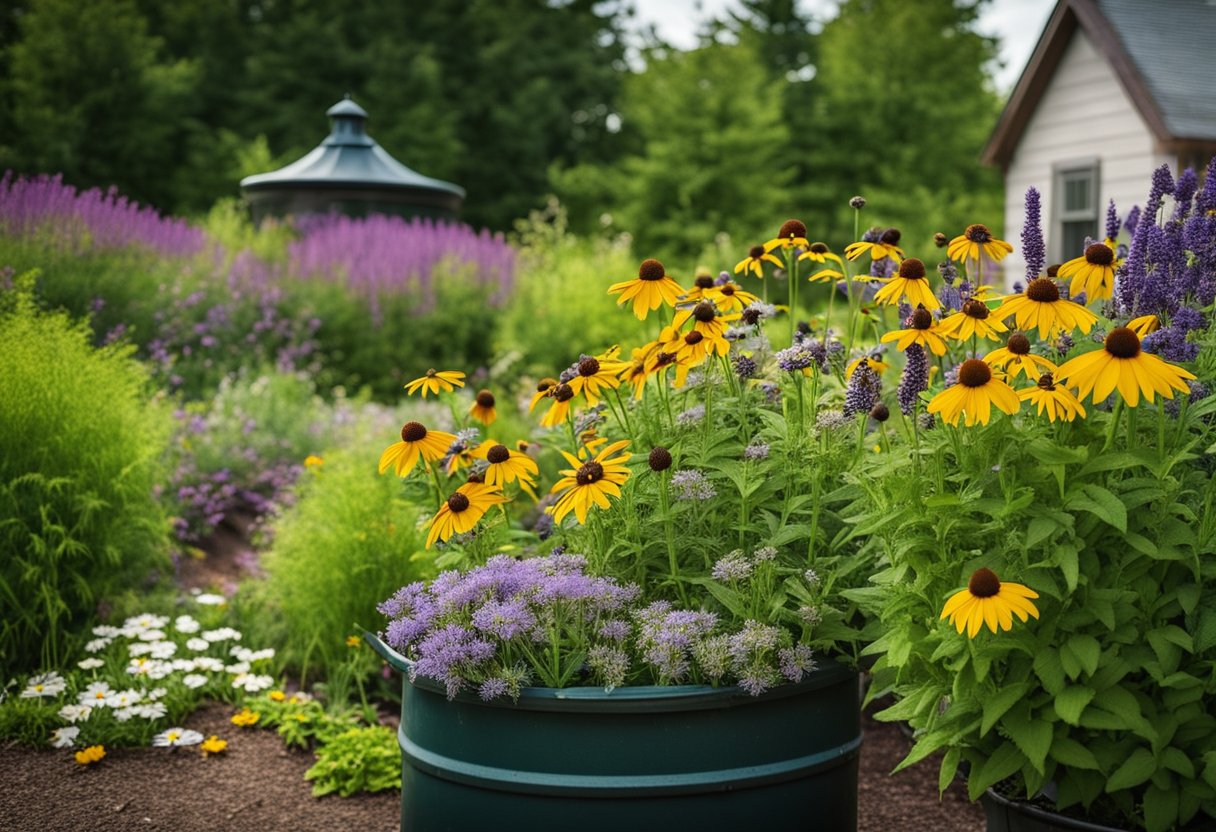
As a gardener, it is important to practice sustainable methods when growing Coneflowers. Here are some sustainable practices that I recommend:
Organic Gardening
Organic gardening is a sustainable practice that involves using natural methods to grow plants. Coneflowers are easy to grow organically, as they are hardy and can tolerate a range of growing conditions. To practice organic gardening with Coneflowers, I recommend using organic fertilizers and avoiding the use of synthetic pesticides. Instead, try using natural pest control methods, such as companion planting with plants that repel pests, like marigolds or basil.
Water Conservation
Water is a precious resource, and it is important to conserve it when growing Coneflowers. One way to conserve water is to plant Coneflowers in areas that receive natural rainfall, or to use a drip irrigation system that delivers water directly to the roots of the plants. Another way to conserve water is to mulch around the base of the plants, which helps to retain moisture in the soil.
Local Flora Integration
Integrating local flora into your garden is a sustainable practice that can help support local ecosystems. Coneflowers are native to North America, and they are an important food source for pollinators, such as bees and butterflies. To support local ecosystems, I recommend planting Coneflowers alongside other native plants that are adapted to your region. This will help to create a diverse and sustainable garden that supports local wildlife.
By practicing sustainable methods such as organic gardening, water conservation, and local flora integration, you can help to create a healthy and thriving garden that supports local ecosystems and promotes sustainability.
Seasonal Care
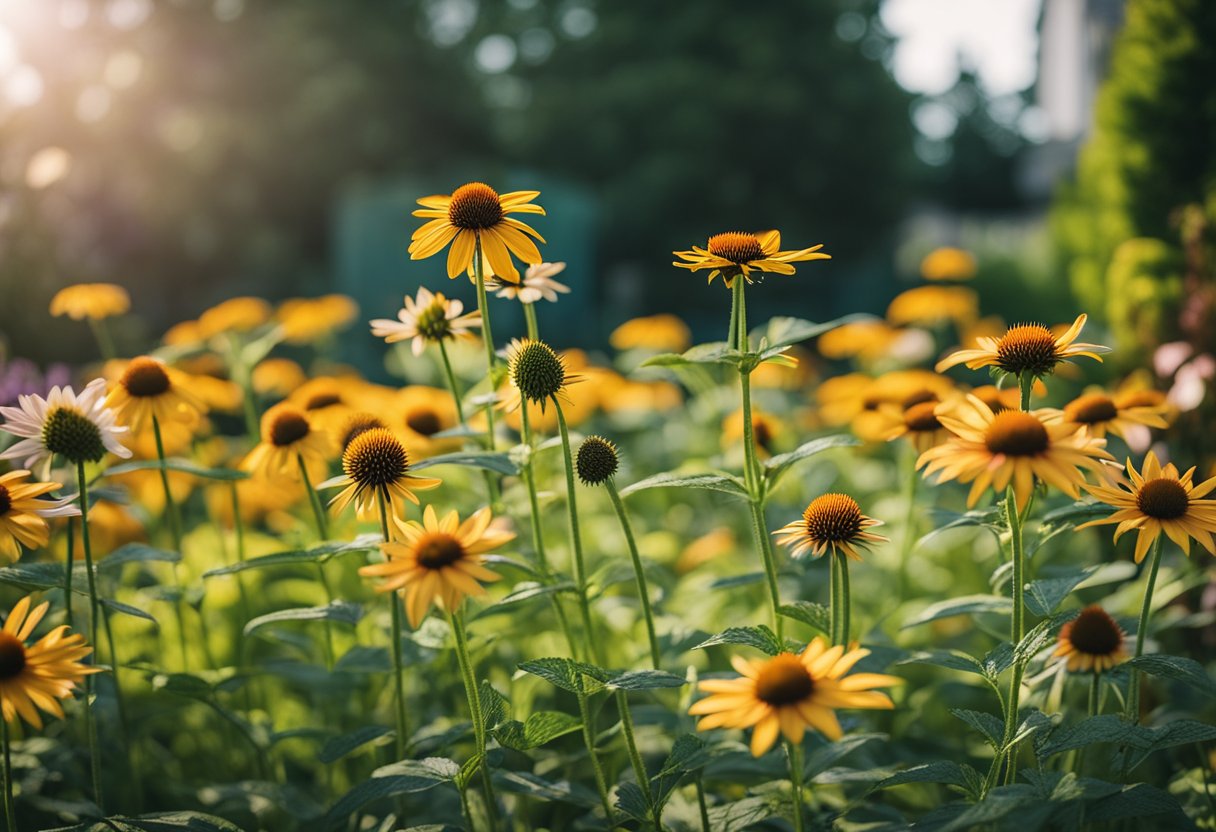
As with any plant, Coneflowers need proper care throughout the year to thrive. Here are some tips for seasonal care:
Spring Preparation
In the spring, it is important to prepare the soil for planting. Coneflowers prefer well-draining soil with a pH between 6.0 and 7.0. Before planting, amend the soil with compost or other organic matter to improve drainage and fertility.
Once planted, water the Coneflowers deeply and regularly, especially during dry spells. Mulching around the plants can help retain moisture in the soil and suppress weeds.
Summer Maintenance
Coneflowers are fairly low-maintenance plants, but they do benefit from deadheading. Removing spent flowers can encourage the plant to produce more blooms and prevent self-seeding. Regular deadheading also helps keep the plant looking tidy and attractive.
During hot, dry weather, Coneflowers may benefit from additional watering. Be sure to water deeply and infrequently, rather than shallowly and frequently, to encourage deep root growth.
Fall Cleanup
In the fall, it is important to clean up the garden to prevent the spread of disease and pests. Remove any dead or diseased foliage from the Coneflowers and surrounding plants, and dispose of it in the trash. Do not compost diseased plant material.
If you plan to divide your Coneflowers, fall is a good time to do so. Dividing the plants every few years can help rejuvenate them and prevent overcrowding.
Winter Protection
Coneflowers are hardy plants and can survive cold temperatures, but they may benefit from some winter protection. Applying a layer of mulch around the base of the plant can help insulate the roots and prevent heaving during freeze-thaw cycles.
Avoid cutting back the foliage in the fall, as the dead stems can help protect the plant from winter weather. Wait until spring to cut back the old growth and prepare the plant for the growing season ahead.
By following these seasonal care tips, you can help your Coneflowers thrive and produce beautiful blooms year after year.
Troubleshooting Tips
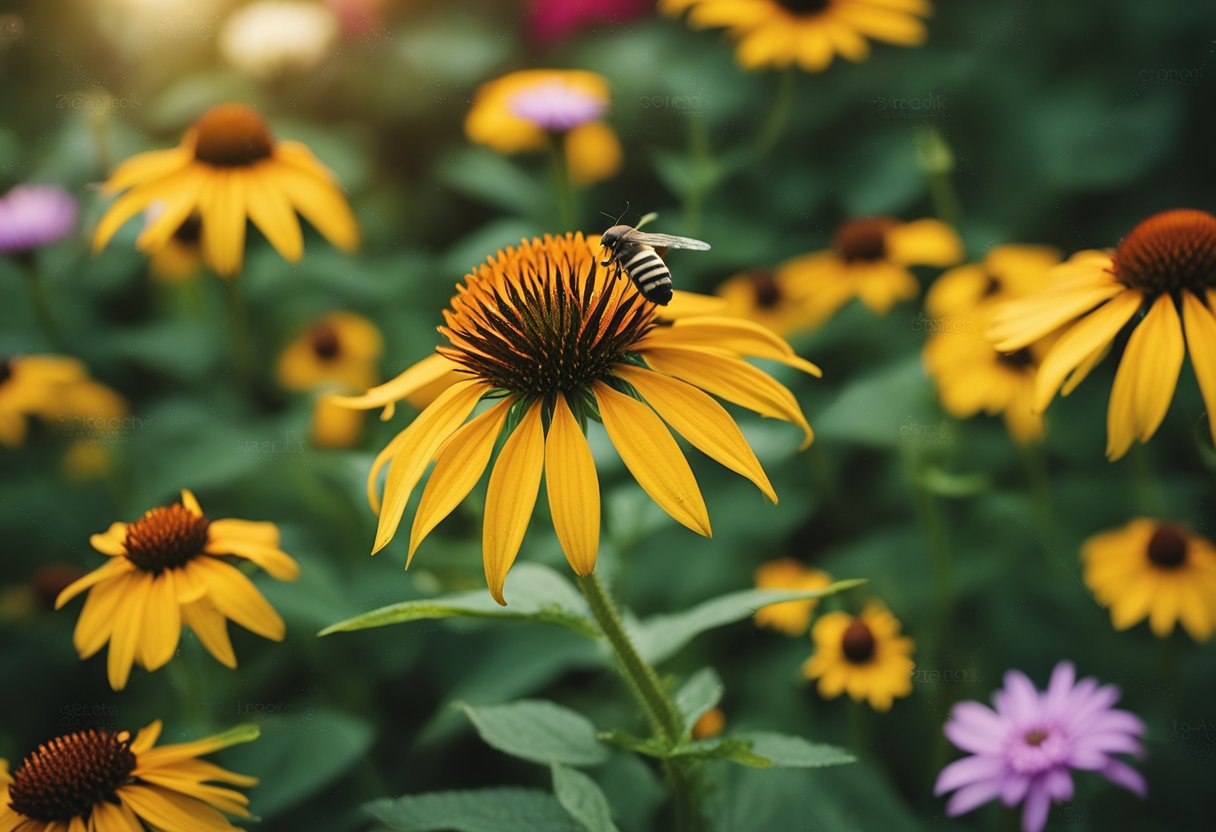
As with any garden, problems can arise when growing coneflowers and their companion plants. Here are some common issues you may encounter and how to resolve them.
Pest Identification
One of the most common problems you may encounter when growing coneflower companion plants is pest infestations. Some pests that may attack these plants include aphids, spider mites, and Japanese beetles. It’s important to identify the pest before attempting to control it, as different pests may require different treatments.
To identify the pest, examine the plant closely, looking for signs of damage and the presence of the pest itself. Once you’ve identified the pest, you can choose an appropriate treatment method. For example, aphids can be controlled with a strong stream of water or insecticidal soap, while spider mites can be treated with neem oil or insecticidal soap.
Resolving Nutrient Deficiencies
Another problem you may encounter when growing coneflower companion plants is nutrient deficiencies. Nutrient deficiencies can cause a range of problems, including stunted growth, yellowing leaves, and poor flowering. To resolve nutrient deficiencies, you’ll need to identify which nutrient is lacking and provide the plant with the appropriate fertilizer.
Common nutrient deficiencies in coneflower companion plants include nitrogen, phosphorus, and potassium. Nitrogen deficiency can be resolved with a high-nitrogen fertilizer, while phosphorus deficiency can be resolved with a high-phosphorus fertilizer. Potassium deficiency can be resolved with a high-potassium fertilizer.
Managing Overcrowding
Overcrowding can also be a problem when growing coneflower companion plants. Overcrowding can lead to poor air circulation, which can increase the risk of disease and pest infestations. It can also lead to competition for nutrients and water, which can stunt growth and reduce flowering.
To manage overcrowding, you’ll need to thin out the plants. Remove any plants that are weak or diseased, as well as any plants that are growing too close together. This will allow the remaining plants to have more space and access to nutrients and water, which will promote healthy growth and flowering.
FAQs – Coneflower Companion Plants
What are the best companion plants for coneflowers in a garden bed?
Coneflowers are a great addition to any garden bed, and they can be paired with a variety of other plants to create a beautiful and diverse landscape. Some of the best companion plants for coneflowers include Black-eyed Susans, Shasta Daisies, Salvia, and Daylilies. These plants all have similar growing requirements to coneflowers and can help to create a cohesive color scheme.
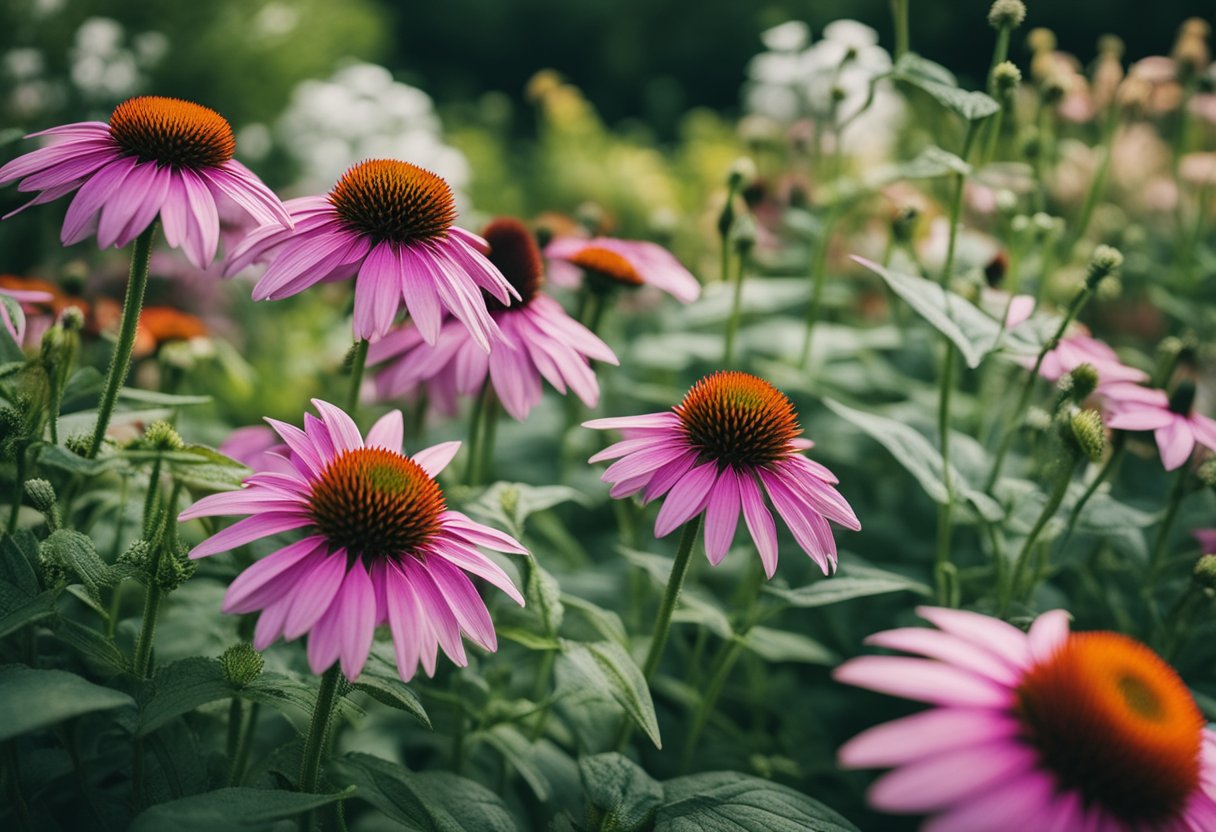
Which ornamental grasses pair well with coneflowers in landscaping?
Ornamental grasses can add texture and interest to a garden bed, and they pair particularly well with coneflowers. Some of the best ornamental grasses to pair with coneflowers include Blue Fescue, Little Bluestem, and Feather Reed Grass. These grasses have a similar growing habit to coneflowers and can help to create a natural, prairie-style look.
Can you suggest flowers that complement coneflower colors in a mixed border?
Coneflowers come in a wide range of colors, from bright pink to deep purple, and there are many flowers that can complement their colors in a mixed border. Some great options include Liatris, Russian Sage, and Purple Coneflower. These plants have similar growing requirements to coneflowers and can help to create a cohesive and visually appealing border.
How should coneflowers be spaced when planting for optimal growth?
When planting coneflowers, it’s important to give them enough space to grow and thrive. A good rule of thumb is to space them about 18-24 inches apart, depending on the variety. This will give them enough room to spread out and will help to prevent overcrowding.
What are some effective planting strategies for coneflowers in flower beds?
When planting coneflowers in a flower bed, it’s important to consider their growing requirements. They prefer well-drained soil and full sun, so be sure to choose a location that gets plenty of sunlight throughout the day. It’s also a good idea to plant them in groups of three or more, as this will help to create a more visually appealing display.
Are there any plants that should be avoided when planting near coneflowers?
While coneflowers are generally easy to grow and care for, there are some plants that should be avoided when planting near them. These include plants that require a lot of water, as coneflowers prefer well-drained soil and can be susceptible to root rot if they are overwatered. Additionally, plants that are prone to disease or pests should be avoided, as they can spread to the coneflowers and cause damage.